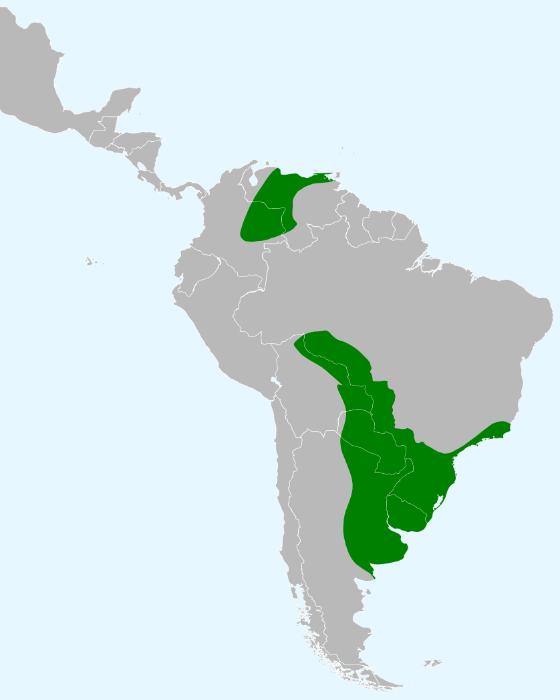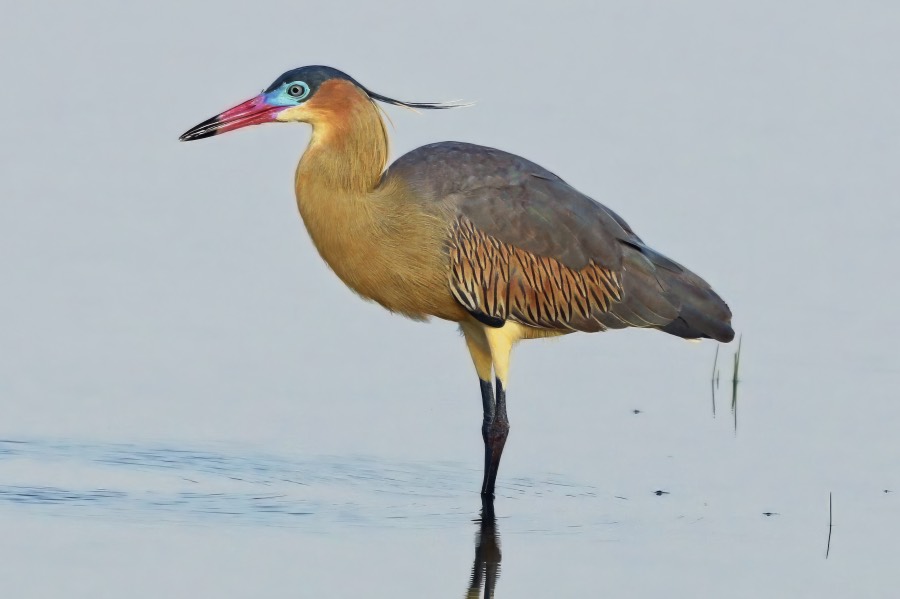Whistling Heron
Whistling Heron
The Whistling heron is a very elegant heron species, with gray and yellowish plumage. The beak is pink and the face is blue. It differs from other herons in many aspects. For example, rather maintaining usual S-like of it neck where flying, it holds its neck more elongated and flaps its wings more quickly and with less amplitude. The species gets its name due to Its high-pitched calls which sound like a long whistle, which it emits when flying. It's typically active only in the daytime, and inhabits open, dry or wet areas, especially rice fields.
Overview
There is little visual differentiation between the males/females - except some minor physical differences on the anal fin. The most obvious indication is likely to be the size as females grow to be considerably larger - reaching 30 kg. By contrast, the males grow only to around 10 kg.
(Syrigma sibilatrix)
Length: 53 cm.
It feeds on arthropods, including dragonflies and beetle larvae, tree frogs, eels (mussuns and tuviras), lizards and water snakes. In dry pastures, they can catch small rodents. When it is concentrated, observing its prey, it keeps its head still while taking a step or two forward, moving its neck laterally. It is normally seen alone or in pairs, but it can occur in groups of 30 to 40 birds, as we observed in September 1999, in the Pantanal.
Curiosities
- Generally, these herons live in pairs, but they never fly side by side. Therefore, whenever you see one of them flying, look for the other, which should appear a few seconds later.
- The typical egg laying pattern varies between three and four eggs.
- Little is known about their reproduction, other than that incubation and molting of young takes about two months.
Behaviour and Habitat
Dorado are migratory - moving up and down the regions' connected river systems as the seasons, temperature and food sources change. They occupy a range of freshwater environments stretching across southern Brazil, northern Argentina, Uruguay, and into Bolivia and Paraguay. This habitat includes the river basins of the Paraguai (and Pantanal), Uruguai, Chaparé, and Mamoré Rivers, plus the drainage area of the Lagoa dos Patos lagoon in the Brazilian state of Rio Grande do Sul. Close relatives of the dorado can also be found in the Rio São Francisco (Salminus franciscanus); the upper Paraná, Amazon and Orinoco basins (Salminus hilarii or tabarana); and in the Santiago and Magdalena basins of Ecuador and Colombia (Salminus affinis or Dorada/Rubia).
Scientific Name
Syrigma sibilatrix

Local Name
Maria-faceira

Description
This is a striking bird species found primarily in wetland habitats such as marshes, swamps, and flooded grasslands. It has a typical heron-like appearance, with long legs, a slender body and neck and long bill. It's coloration is distinctive - with a combination of grey, white, and rusty-brown plumage. It's beak is pink, it's face is blue, and has long trailing crest feather at the back of its head, It inhabits open areas - including fields and wetlands
Reproduction
Females reach maturity at around 4 or 5 years of age, and will start to take part in the annual spawning. Each female dorado can deposit up to 2 million eggs. The emergence of the young fish coincides with the period of peak food availability - making it a little easier dorado to survive. However, the eggs and young dorado are defenceless - meaning that they also make a good meal for other opportunistic predators (including other larger dorado). As a result, few young dorado ever reach maturity. Notably, immature dorado are silver in colour - making them easily confused with the closely-related Tabarana (Salminus hilarii). However, they yellow-gold tone gets strong as the dorado age. These are a slow-growth fish - with a lifespan exceeding 15 years. Sadly, increased environmental pressures and overfishing across much of its range mean that fewer fish are reaching this age - with both their size and numbers decreasing.
Whistling heron in the Pantanal. Credit: Charles Sharp.
Sports Fishing
Conservation and Threats
Quick Facts
- Dorado are the largest scaled fish found in the Pantanal. However, they can be outsized by large catfish and stingrays.
- Dorado can leap up to one metre out of the water. This can be seen when attacking prey, or when caught and trying to escape the line.
- Visitors to the region around Bonito, where fishing is prohibited, can swim in clear water streams, observing large Dorados swimming quietly around. It is probably the only location offering this experience.
- The Dorado is the feature fish on a sixth season episode of River Monsters, titled "River of Blood". This was filmed along the Rio Paraná (flowing from southern Brazil into Argentina) and Rio Uruguai. It focused on the Dorado's aggressive predatory reputation.
- The dorado has several other common names or nicknames including: Pirajú, o Rei do rio or King of the river (Brazil), and el tigre del rio or River Tiger (Argentina).
RELATED LINKS
Banner image: A pair of Whistling Cranes taking off from within the Parque das Nações Indigenas in Campo Grande (Andrew Mercer)

